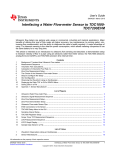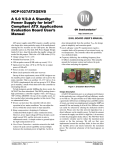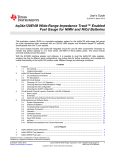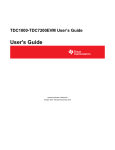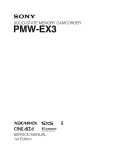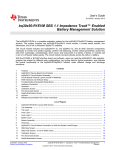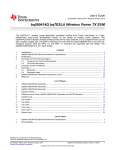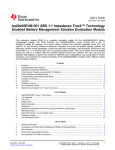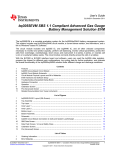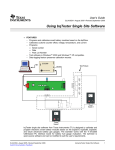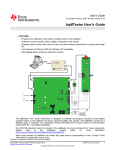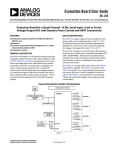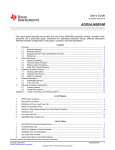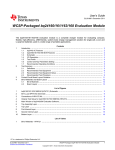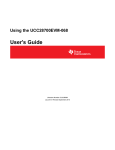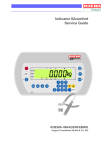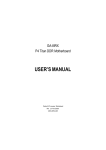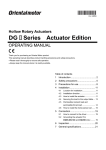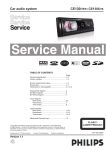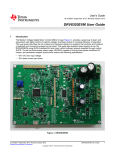Download bq40z50EVM Li-Ion Battery Pack Manager
Transcript
User's Guide SLUUAV7A – December 2013 – Revised July 2015 bq40z50EVM Li-Ion Battery Pack Manager Evaluation Module This evaluation module (EVM) is a complete evaluation system for the bq40z50 or bq296000 battery management system. The EVM includes one bq40z50 and bq296000 circuit module and a link to Windows™ based PC software. The circuit module includes one bq40z50 integrated circuit (IC), one bq296000 IC, and all other onboard components necessary to monitor and predict capacity, perform cell balancing, monitor critical parameters, protect the cells from overcharge, over-discharge, short-circuit, and overcurrent in 1-, 2-, 3-, or 4-series cell Li-ion or Li-polymer battery packs. The circuit module connects directly across the cells in a battery. With the EV2300 or EV2400 interface board and software, the user can read the bq40z50 data registers, program the chipset for different pack configurations, log cycling data for further evaluation, and evaluate the overall functionality of the solution under different charge and discharge conditions. 1 2 3 4 5 6 7 Contents Features ....................................................................................................................... 2 1.1 Kit Contents.......................................................................................................... 2 1.2 Ordering Information ............................................................................................... 2 1.3 Documentation ...................................................................................................... 2 1.4 bq40z50 and bq296000 Circuit Module Performance Specification Summary ............................. 2 bq40z50EVM Quick Start Guide ........................................................................................... 3 2.1 Items Needed for EVM Setup and Evaluation .................................................................. 3 2.2 Software Installation ................................................................................................ 3 2.3 EVM Connections ................................................................................................... 3 Battery Management Studio ................................................................................................ 6 3.1 Registers Screen.................................................................................................... 6 3.2 Setting Programmable bq40z50 Options ........................................................................ 6 3.3 Calibration Screen .................................................................................................. 7 3.4 Chemistry Screen ................................................................................................... 9 3.5 Firmware Screen .................................................................................................. 10 3.6 Advanced Comm SMB Screen .................................................................................. 11 bq40z50EVM Circuit Module Schematic ................................................................................ 12 4.1 Pre-Charge ......................................................................................................... 12 4.2 LED Control ........................................................................................................ 12 4.3 Emergency Shutdown ............................................................................................ 12 4.4 Testing Fuse-Blowing Circuit .................................................................................... 12 4.5 PTC Thermistor ................................................................................................... 13 Circuit Module Physical Layouts ......................................................................................... 14 5.1 Board Layout ....................................................................................................... 14 5.2 Schematic .......................................................................................................... 17 Bill of Materials ............................................................................................................. 18 Related Documentation from Texas Instruments ...................................................................... 19 List of Figures 1 bq40z50 Circuit Module Connection to Cells and System Load or Charger ......................................... 4 2 Cell Connection Configuration 3 4 ............................................................................................. Registers Screen............................................................................................................. Data Flash Screen ........................................................................................................... SLUUAV7A – December 2013 – Revised July 2015 Submit Documentation Feedback bq40z50EVM Li-Ion Battery Pack Manager Evaluation Module Copyright © 2013–2015, Texas Instruments Incorporated 4 6 7 1 Features www.ti.com 5 Calibration Screen ........................................................................................................... 7 6 Chemistry Screen ............................................................................................................ 9 7 Firmware Screen ........................................................................................................... 10 8 Advanced Comm Screen .................................................................................................. 11 9 Fuse Trace Modifications.................................................................................................. 12 10 Top Silk Screen ............................................................................................................. 14 11 Bottom Silk Screen ......................................................................................................... 14 12 Top Assembly ............................................................................................................... 14 13 Bottom Assembly ........................................................................................................... 15 14 Top Layer.................................................................................................................... 15 15 Internal Layer 1 ............................................................................................................. 15 16 Internal Layer 2 ............................................................................................................. 16 17 Bottom Layer ................................................................................................................ 16 1 Features • • • 1.1 Kit Contents • • 1.2 Complete evaluation system for the bq40z50EVM Li-Ion Battery Pack Manager Evaluation Module and bq296000 independent overvoltage protection IC Populated circuit module for quick setup Software that allows data logging for system analysis bq40z50 and bq296000 circuit module Cable to connect the EVM to an EV2300 or EV2400 communications interface adapter Ordering Information For complete ordering information, see the product page at www.ti.com. Table 1. Ordering Information 1.3 EVM PART NUMBER CHEMISTRY CONFIGURATION CAPACITY bq40z50EVM-561 Li-ion 1-, 2-, 3-, or 4-cell Any Documentation See the device data sheets for bq40z50 and bq296000 and technical reference manuals (TRMs) on www.ti.com for information on device firmware and hardware. 1.4 bq40z50 and bq296000 Circuit Module Performance Specification Summary This section summarizes the performance specifications of the bq40z50 and bq296000 EVM. Table 2. Performance Specification Summary Specification 2 Minimum Typical Maximum Input voltage Pack+ to Pack– 3 15 26 V Charge and discharge current 0 2 7 A bq40z50EVM Li-Ion Battery Pack Manager Evaluation Module Units SLUUAV7A – December 2013 – Revised July 2015 Submit Documentation Feedback Copyright © 2013–2015, Texas Instruments Incorporated bq40z50EVM Quick Start Guide www.ti.com 2 bq40z50EVM Quick Start Guide This section provides the step-by-step procedures required to use a new EVM and configure it for operation in a laboratory environment. 2.1 Items Needed for EVM Setup and Evaluation • • • • • • • • 2.2 bq40z50 or bq296000 circuit module EV2300 or EV2400 communications interface adapter Cable to connect the EVM to an EV2300 or EV2400 communications interface adapter USB cable to connect the communications interface adapter to the computer Computer setup with Windows XP™, or higher, operating system Access to the Internet to download the Battery Management Studio software setup program One-to-four battery cells or 1-kΩ resistors to configure a cell simulator A DC power supply that can supply 16.8 V and 2 A (constant current and constant voltage capability is desirable) Software Installation Find the latest software version in the bq40z50 tool folder on www.ti.com. Use the following steps to install the bq40z50 Battery Management Studio software: 1. Download and run the Battery Management Studio setup program from the Development Tools section of the bq40z50EVM product folder on www.ti.com. See Section 3 for detailed information on using the tools in the Battery Management Studio. 2. If the communications interface adapter was not previously installed, after the Battery Management Studio installation, a TI USB driver installer pops up. Click “Yes” for the agreement message and follow its instructions. Two drivers are associated with the EV2300 and an additional file may be required for the EV2400. Follow the instructions to install both. Do not reboot the computer, even if asked to do so. 3. Plug the communications interface adapter into a USB port using the USB cable. The Windows™ system may show a prompt that new hardware has been found. When asked, "Can Windows connect to Windows Update to search for software?", select "No, not this time", and click "Next". In the next dialog window, it indicates "This wizard helps you install software for: TI USB Firmware Updater". Select "Install the software automatically (Recommended)" and click "Next". It is common for the next screen to be the Confirm File Replace screen. Click "No" to continue. If this screen does not appear, then go to the next step. After Windows™ indicates that the installation was finished, a similar dialog window pops up to install the second driver. Proceed with the same installation preference as the first one. The second driver is TI USB bq80xx Driver. 2.3 EVM Connections This section covers the hardware connections for the EVM. See Figure 1. SLUUAV7A – December 2013 – Revised July 2015 Submit Documentation Feedback bq40z50EVM Li-Ion Battery Pack Manager Evaluation Module Copyright © 2013–2015, Texas Instruments Incorporated 3 bq40z50EVM Quick Start Guide www.ti.com EV2300 PACK– SYS PRES PACK+ SMBC VSS – + SMBD Load/Charger Figure 1. bq40z50 Circuit Module Connection to Cells and System Load or Charger • Direct connection to the cells: 1N (BAT–), 1P, 2P, 3P, 4P (BAT+) Attach the cells to the J1 and J5 terminal block. A specific cell connection sequence is not required; although, it is good practice to start with lowest cell in the stack (cell 1), then attach cells 2 through 4 in sequence. The U1 and U2 devices should not be damaged by other cell connection sequences, but there is a possibility that the bq296000 could blow the fuse. Attaching cells starting with cell 1 should eliminate this risk. A short should be placed across unused voltage sense inputs. See Figure 2. Number of Cells 1 2 3 4 1N ‐cell1+ ‐cell1+ ‐cell1+ ‐cell1+ J1 and J5 Terminal Block Connections 1P 2P 3P short short ‐cell2+ short ‐cell2+ ‐cell3+ ‐cell2+ ‐cell3+ 4P short short short ‐cell4+ Figure 2. Cell Connection Configuration • • • 4 A resistor cell simulator can be used instead of battery cells. Connect a resistor between each of the contacts on the J1 or J5 connector. For example, from 1N to 1P, from 1P to 2P, and so forth, until the desired number of cells has been achieved. A power supply can provide power to the cell simulator. Set the power supply to the desired cell voltage × the number of cells and attach the ground wire to 1N and the positive wire to 4P. For example, for a 3S configuration with a 3.6-V cell voltage, set the power supply to 3 × 3.6 = 10.8 V. Serial communications port (SMBC, SMBD) Attach the communications interface adapter cable to J2 and to the SMB port on the EV2300. System load and charger connections across PACK+ and PACK– Attach the load or power supply to the J3 or J4 terminal block. The positive load or power supply wire should be connected to at least one of the first two terminal block positions labeled PACK+. The ground wire for the load or power supply should be connected to the last terminal block positions labeled PACK–. System-present pin (SYS PRES) To start charge or discharge test, connect the SYS PRES position on the J3 terminal block to PACK–. bq40z50EVM Li-Ion Battery Pack Manager Evaluation Module SLUUAV7A – December 2013 – Revised July 2015 Submit Documentation Feedback Copyright © 2013–2015, Texas Instruments Incorporated bq40z50EVM Quick Start Guide www.ti.com • • The SYS PRES can be left open if the non-removable (NR) bit is set to 1 in the Pack Configuration A register. To test sleep mode, disconnect the SYS PRES pin. Wake-up the device up from shutdown (WAKE) Press the Wake pushbutton switch to temporarily connect Bat+ to Pack+. This applies voltage to the PACK pin on the bq40z50 to power-up the regulators and start the initialization sequence. Parameter setup The default data flash settings configure the device for 3-series Li-Ion cells. The user should change the | Data Flash | Settings | DA Configuration register to set up the number of series cells to match the physical pack configuration. This provides basic functionality to the setup. Other data flash parameters should also be updated to fine tune the gauge to the pack. See the bq40z50 TRM for help with setting the parameters. SLUUAV7A – December 2013 – Revised July 2015 Submit Documentation Feedback bq40z50EVM Li-Ion Battery Pack Manager Evaluation Module Copyright © 2013–2015, Texas Instruments Incorporated 5 Battery Management Studio www.ti.com 3 Battery Management Studio 3.1 Registers Screen Run Battery Management Studio from the Start | Programs | Texas Instruments | Battery Management Studio menu sequence, or the Battery Management Studio shortcut. The Registers screen (see Figure 3) appears. The Registers section contains parameters used to monitor gauging. The Bit Registers section provides bit level picture of status and fault registers. A green flag indicates that the bit is 0 (low state) and a red flag indicates that the bit is 1 (high state). Data begins to appear once the Refresh (single-time scan) button is selected, or it scans continuously if the Scan button is selected. Figure 3. Registers Screen The continuous scanning period can be set via the | Window | Preferences | SBS | Scan Interval | menu selections. The Battery Management Studio program provides a logging function which logs the values that are selected by the Log check boxes located beside each parameter in the Register section. To enable this function, select the Log button; this causes the Scan button to be selected. When logging is stopped, the Scan button is still selected and has to be manually deselected. 3.2 Setting Programmable bq40z50 Options The bq40z50 data flash comes configured per the default settings detailed in the bq40z50 TRM. Ensure that the settings are correctly changed to match the pack and application for the solution being evaluated. NOTE: The correct setting of these options is essential to get the best performance. The settings can be configured using the Data Flash screen (see Figure 4). 6 bq40z50EVM Li-Ion Battery Pack Manager Evaluation Module SLUUAV7A – December 2013 – Revised July 2015 Submit Documentation Feedback Copyright © 2013–2015, Texas Instruments Incorporated Battery Management Studio www.ti.com Figure 4. Data Flash Screen 3.3 Calibration Screen The voltages, temperatures, and currents should be calibrated to provide good gauging performance. Press the Calibration button to select the Advanced Calibration window. See Figure 5. Figure 5. Calibration Screen SLUUAV7A – December 2013 – Revised July 2015 Submit Documentation Feedback bq40z50EVM Li-Ion Battery Pack Manager Evaluation Module Copyright © 2013–2015, Texas Instruments Incorporated 7 Battery Management Studio 3.3.1 • • • • • 3.3.2 3.3.3 www.ti.com Voltage Calibration Measure the voltage from Cell 1 to 1N and enter this value in the Applied Cell 1 Voltage field and select the Calibrate Voltage box. Measure the voltage from Bat+ to Bat– and enter this value in the Applied Battery Voltage field and select the Calibrate Battery Voltage box. Measure the voltage from Pack+ to Pack– and enter this value in the Applied Pack Voltage field and select the Calibrate Pack Voltage box. If the voltage is not present, then turn the charge and discharge FETs on by entering a 0x0022 command in the Manufacturer Access register on the Register screen. Press the Calibrate Gas Gauge button to calibrate the voltage measurement system. Deselect the Calibrate Voltage boxes after voltage calibration has completed. Temperature Calibration • Enter the room temperature in each of the Applied Temperature fields and select the Calibrate box for each thermistor to be calibrated. The temperature values must be entered in degrees Celsius. • Press the Calibrate Gas Gauge button to calibrate the temperature measurement system. • Deselect the Calibrate boxes after temperature calibration has completed. Current Calibration The Board Offset calibration option is not offered in Battery Management Studio, because it is not required when using the bq40z50EVM. The Board Offset calibration option is available in bqProduction. • Connect and measure a 2-A current source from 1N (–) and Pack– (+) to calibrate without using the FETs. (TI does not recommend calibration using the FETs.) • Enter –2000 in the Applied Current field and select the Calibrate Current box. • Press the Calibrate Gas Gauge button to calibrate. • Deselect the Calibrate Current box after current calibration has completed. NOTE: Current can also be calibrated using the FETs. Measure the current in the discharge path and enter this value in the Applied Current field. 8 bq40z50EVM Li-Ion Battery Pack Manager Evaluation Module SLUUAV7A – December 2013 – Revised July 2015 Submit Documentation Feedback Copyright © 2013–2015, Texas Instruments Incorporated Battery Management Studio www.ti.com 3.4 Chemistry Screen The chemistry file contains parameters that the simulations use to model the cell and its operating profile. It is critical to program a Chemistry ID that matches the cell into the device. Some of these parameters can be viewed in the Data Flash section of the Battery Management Studio. Press the Chemistry button to select the Chemistry window. Figure 6. Chemistry Screen • • • The table can be sorted by clicking the desired column. for example: Click the Chemistry ID column header. Select the ChemID that matches your cell from the table (see Figure 6). Press the Update Chemistry in the Data Flash button to update the chemistry in the device. SLUUAV7A – December 2013 – Revised July 2015 Submit Documentation Feedback bq40z50EVM Li-Ion Battery Pack Manager Evaluation Module Copyright © 2013–2015, Texas Instruments Incorporated 9 Battery Management Studio 3.5 www.ti.com Firmware Screen Press the Firmware button to select the Firmware Update window. This window allows the user to export and import the device firmware. Figure 7. Firmware Screen 3.5.1 Programming the Flash Memory The upper section of the Firmware screen is used to initialize the device by loading the default .srec into the flash memory (see Figure 7). • Search for the .srec file using the Browse button. • Select the Execute after programming box to automatically return the device to Normal mode after programming has completed. • Press the Program button and wait for the download to complete. 3.5.2 Exporting the Flash Memory The lower section of the Firmware screen is used to export all of the flash memory from the device (see Figure 7). • Press the Browse button and enter an .srec filename. • Press the Read Srec to save the flash memory contents to the file. Wait for the download to complete. 10 bq40z50EVM Li-Ion Battery Pack Manager Evaluation Module SLUUAV7A – December 2013 – Revised July 2015 Submit Documentation Feedback Copyright © 2013–2015, Texas Instruments Incorporated Battery Management Studio www.ti.com 3.6 Advanced Comm SMB Screen Press the Advanced Comm SMB button to select the Advanced SMB Comm window. This tool provides access to parameters using SMB and Manufacturing Access commands. See Figure 8. Figure 8. Advanced Comm Screen Examples: Reading an SMB Command. • Read SBData Voltage (0x09) – SMBus Read Word. Command = 0x09 – Word = 0x3A7B, which is hexadecimal for 14971 mV Sending a MAC Gauging() to enable IT via ManufacturerAccess(). • With Impedance Track™ disabled, send Gauging() (0x0021) to ManufacturerAccess(). – SMBus Write Word. Command = 0x00. Data = 00 21 Reading Chemical ID() (0x0006) via ManufacturerAccess() • Send Chemical ID() to ManufacturerAccess() – SMBus Write Word. Command = 0x00. Data sent = 00 06 • Read the result from ManufacturerData() – SMBus Read Block. Command = 0x23. Data read = 00 01 – That is 0x0100, chem ID 100 SLUUAV7A – December 2013 – Revised July 2015 Submit Documentation Feedback bq40z50EVM Li-Ion Battery Pack Manager Evaluation Module Copyright © 2013–2015, Texas Instruments Incorporated 11 bq40z50EVM Circuit Module Schematic 4 www.ti.com bq40z50EVM Circuit Module Schematic This section contains information on modifying the EVM and using various features on the reference design. 4.1 Pre-Charge The EVM provides a power resistor and FET to support a reduced current pre-charge path to charge the pack when cell voltages are below the pre-charge voltage threshold. This reduces heating that could lead to cell damage or reduced operating lifetime. The resistor (R1) is set up to limit the current to less than 40 mA for a 4S configuration. The user can change R1 to setup the pre-charge current to a different value. 4.2 LED Control The EVM is configured to support five LEDs to provide state-of-charge information for the cells. The LED interface is enabled by entering a 0x0027 command in the Manufacturing Access register on the Registers screen. Press the LED DISPLAY button to illuminate the LEDs for approximately 5 seconds. 4.3 Emergency Shutdown The Emergency Shutdown function allows the user to disable the charge and discharge FETs with an external GPIO pin. The EMSHUT and NR bits must be set high in the DA Configuration register to enable this feature. Press the SHUTDOWN pushbutton switch for one second to disable these FETs, and press it again for one second to enable them. NOTE: Remember to remove the SYS PRES-to-PACK– short, if present. 4.4 Testing Fuse-Blowing Circuit To prevent the loss of board functionality during the fuse-blowing test, the actual chemical fuse is not provided on the EVM. FET Q5 drives the FUSE test point low if a fuse-blow condition occurs. FUSE is attached to an open drain FET, so a pull-up resistor is required to check whether the FUSE pulls low. A FUSEPIN test point is attached to the gate of Q5; so, monitoring FUSEPIN can be used to test this condition without adding a pull-up resistor. Fuse placement on the application board is shown in the bq40z50 data sheet. A chemical fuse can also be soldered to the EVM for in-system testing. A copper bridge is included on the PCB to bypass the chemical fuse, so it has to be cut to allow the fuse to open the power path. The cut is illustrated in yellow on Figure 9 with arrows pointing to the location. Cut Copper here. Top Layer Bottom Layer Figure 9. Fuse Trace Modifications 12 bq40z50EVM Li-Ion Battery Pack Manager Evaluation Module SLUUAV7A – December 2013 – Revised July 2015 Submit Documentation Feedback Copyright © 2013–2015, Texas Instruments Incorporated bq40z50EVM Circuit Module Schematic www.ti.com 4.5 PTC Thermistor The PTC interface is designed to work with a specific PTC thermistor. The thermistor must have a 10-kΩ typical resistance over the normal operating temperature range and the resistance must be greater than 1.2 MΩ at the PTC trip temperature. The muRata PRF18BA103QB1RB thermistor will work with this device. The EVM has a 10-kΩ resistor installed on the PTC footprint. The PTC function can be disabled by connecting PTC and PTCEN to VSS. SLUUAV7A – December 2013 – Revised July 2015 Submit Documentation Feedback bq40z50EVM Li-Ion Battery Pack Manager Evaluation Module Copyright © 2013–2015, Texas Instruments Incorporated 13 Circuit Module Physical Layouts 5 www.ti.com Circuit Module Physical Layouts This section contains the printed-circuit board (PCB) layout, assembly drawings, and schematic for the bq40z50 and bq296000 circuit modules. 5.1 Board Layout This section shows the dimensions, PCB layers (see through Figure 17), and assembly drawing for the bq40z50 modules. Figure 10. Top Silk Screen Figure 11. Bottom Silk Screen Figure 12. Top Assembly 14 bq40z50EVM Li-Ion Battery Pack Manager Evaluation Module SLUUAV7A – December 2013 – Revised July 2015 Submit Documentation Feedback Copyright © 2013–2015, Texas Instruments Incorporated Circuit Module Physical Layouts www.ti.com Figure 13. Bottom Assembly 4250 mil 1250 mil Figure 14. Top Layer 4250 mil 1250 mil Figure 15. Internal Layer 1 SLUUAV7A – December 2013 – Revised July 2015 Submit Documentation Feedback bq40z50EVM Li-Ion Battery Pack Manager Evaluation Module Copyright © 2013–2015, Texas Instruments Incorporated 15 Circuit Module Physical Layouts www.ti.com 4250 mil 1250 mil Figure 16. Internal Layer 2 4250 mil 1250 mil Figure 17. Bottom Layer 16 bq40z50EVM Li-Ion Battery Pack Manager Evaluation Module SLUUAV7A – December 2013 – Revised July 2015 Submit Documentation Feedback Copyright © 2013–2015, Texas Instruments Incorporated Circuit Module Physical Layouts www.ti.com 5.2 Schematic C1 C2 0.1 µF 0.1 µF 4P R1 3 2 Q1 FDN358P 1 300 F1 PACK+ 2 3 2 1 R2 10M R3 Q3 Si7114DN Q2 Si7114DN 10M 4 SFDxxxx 4 3 5 1 2 3 2 DNP 5 FUSE 1 R5 Q4 2N7002K 1 3 1 Wake 1 R4 10M 4P Q5 Si1414DH 7 VSS PWPD 6 9 R8 R9 R10 5.1K 100 5.1K DSG R6 C3 51K R33 5.1 R12 1 REG CHGND R7 5.1K 10K 0.1 µF CHG TP11 1 R14 3 1 C4 0.1 µF 8 4 R13 1K OUT 1 U2 1 VDD 2 V4 3 V3 4 V2 5 V1 S1 3 FUSEPIN 1 6 100 PACK+ 10K 5 2 1 R11 R32 10K P 0.1 µF C6 R15 0.1 µF C9 0.1 µF R18 R17 5.1K 5.1K RT1 0.1 µF C8 0.1 µF 10K BAT GND C10 0.1 µF 2 BAT VCC 25 BAT J4 1 2 FUSE 26 28 29 30 31 27 PACK DSG NC PWPD 0.1 µF CHG C11 PCHG 1 33 1 BAT GND 1K R16 32 1K C12 AGND C7 0.47µF BAT 4P C5 1 1K BQ296100DSGT 1 2 3 RT4 RT5 10K 10K 10K C19 DNP DNP 100 GND GND 1 1 2 GND SIDE 2 GND SIDE 1 1 SMBD SMBC 1 100 1 SHUTDOWN 0.1 µF C20 R31 DNP GND DNP 100 2001 2DNP S3 GND C21 DNP DNP 4 SMBC J6 C18 R30 100 R27 3 SMBD 2 SMBC 1 VSS J2 CHGND R28 R29 200 1K D2 D3 D4 CHGND GND GND SIDE RT3 10K 200 R26 MM3Z5V6C RT2 R25 SMBD 1 GND R24 S2 LED DISPLAY GND TP12 1 1 1 ND SM BC 1 TS4 NC 15 14 13 SRN 1 SRP GND GND 1 NT1 Net-Tie CHGND LED2 SMBD 1 1 12 9 1 TS3 TP3 100 TS2 100 GND R23 VSS 1 2 SMBC 19 D9 LED5 J3 D8 D7 LED1 1 100 R22 3 LEDCNTLA 2 R21 TS1 100 21 20 SMBD 18 DISP 17 11 2 0.1 µF 3 D6 LED4 22 LEDCNTLB 7 NC 8 SRP C17 10 R20 23 BTP_INT 16 PRESorSHUTDN 0.1 µF 1 PTC D5 LED3 GND SIDE 2 C16 PTCEN 24 LEDCNTLC BQ40Z50RSM-R1 5 VC1 6 SRN C15 0.1 µF 1 U1 3 VC3 4 VC2 C14 0.1 µF 2.2 µF 1 PBI 2 VC4 MM3Z5V6C C13 MM3Z5V6C D1 BAT54HT1G CHGND GND R19 GND 0.001 1 IC ground should be connected to the 1N cell tab. 2 Place RT1 close to Q2 and Q3. 3 Replace D1 and R9 with a 10 ohm resistor for Single cell applications SLUUAV7A – December 2013 – Revised July 2015 Submit Documentation Feedback bq40z50EVM Li-Ion Battery Pack Manager Evaluation Module Copyright © 2013–2015, Texas Instruments Incorporated 17 Bill of Materials 6 Bill of Materials COUNT 18 www.ti.com RefDes Value Description Size Part Number MFR 16 C1-6, C8-12, C14-18 0.1 µF Capacitor, Ceramic Chip, 50 V, X7R, 20% 0603 C0603C104M5RACTU Kemet 1 C7 0.47 µF Capacitor, Ceramic, 0.47 µF, 10 V, X5R, 10% 0603 C0603C474K8PACTU Kemet 1 C13 2.2 µF Capacitor, Ceramic, 25 V, X7R, 20% 0805 C2012X7R1E225M085AB 0 C19-21 DNP Capacitor, Ceramic, 50 V, X7R, 20% 0603 C0603C104M5RACTU 1 D1 BAT54HT1G Diode, Schottky, 200-mA, 30-V SOD323 BAT54HT1G On Semi 3 D2-4 MM3Z5V6C Diode, Zener, 5.6V, 200mW SOD323 MM3Z5V6C Fairchild 5 D5-9 SML-X23GC LED 2x3mm 565nm GRN WTR CLR SMD 1206 SML-X23GC Lumex 0 F1 DNP Fuse, Slo-Blo Ceramic, xxA, yyyV 1 R1 300 Resistor, Chip, 1W, 5% 2512 CRCW2512300RJNEG Vishay-Dale 3 R2-3, R5 10M Resistor, Chip, 1/10-W, 5% 0603 CRCW060310M0JNEA Vishay-Dale 3 R4, R12, R32 10K Resistor, Chip, 1/10-W, 5% 0603 CRCW060310K0JNEA Vishay-Dale 1 R6 51K Resistor, Chip, 1/16-W, 5% 0603 CRCW060351K0JNEA Vishay-Dale 5 R7-8, R10, R16-17 5.1K Resistor, Chip, 1/10-W, 5% 0603 CRCW06035K10JNEA Vishay-Dale 10 R9, R11, R20-23, R25, R27, R30-31 100 Resistor, Chip, 1/10-W, 5% 0603 CRCW0603100RJNEAHP Vishay-Dale 5 R13-15 R18 R29 Vishay-Dale 1 R19 3 R24, R26, R28 1 R33 2 J1, J4 1 J2 2 J3, J5 0 SFDxxx SFDxxxx TDK Kemet Sony 1K Resistor, Chip, 1/10-W, 5% 0603 CRCW06031K00JNEA 0.001 50ppm Resistor, Chip, 1 watt, ± 1% 1206 CSR1206-0R001F1 200 Resistor, Chip, 1/16-W, 5% 0603 CRCW0603200RJNEA Vishay-Dale 5.1 Resistor, 5.1, 0.063 W, 5%, 0402 0402 CRCW04025R10JNED Vishay-Dale ED555/2DS Terminal Block, 2-pin, 6-A, 3.5mm 0.27 x 0.25 inch ED555/2DS OST 22-05-3041 Header, Friction Lock Ass'y, 4-pin Right Angle, 0.400 x 0.500 inch 22-05-3041 Molex ED555/3DS Terminal Block, 3-pin, 6-A, 3.5mm 0.41 x 0.25 inch ED555/3DS OST J6 Header, TH, 100mil spacing, 2x1, 230 mil above insulator 0.100 inch x PEC02SAAN 2 1 LBL1 Thermal Transfer Printable Labels, 1.250 W x 0.250 H inch - 10,000 per roll 1 RT1 10K Thermistor, NTC, 5 Ω , 1-A 4 RT2-5 10K Thermistor, NTC, 3-A 0.095 X 0.150 inch 103AT-2 3 S1, S2, S3 Switch, Push button, Momentary, 1P1T, 50-mA, 12-V 0.200 x 0.200 inch EVQ-PLHA15 Panasonic 1 TP3 Test Point, Black, Thru Hole Color Keyed 0.100 x 0.100 inch 5001 Keystone 1 Q1 FDN358P Fairchild 2 Q2-3 1 1 EVQ-PLHA15 5001 FDN358P MOSFET, Pch, -30V, -1.5A, 125 mΩ PCB Label 1.250 W x 0.250 H inch 1206 SOT23 THT-13-457-10 CRCW120610K0JNEA Riedon Sullins Brady Vishay Semitec Si7114DN-T1-E3 MOSFET Nch 30V, 11.7A, 7.5 mΩ PWRPAK 1212 Si7114DN-T1-E3 Vishay Q4 2N7002K-T1-E3 MOSFET, Nch, 60V, 300 mA, 2-Ω SOT23 2N7002K-T1-E3 Vishay Q5 Si1414DH-T1-GE3 MOSFET, Nch, 30V, 4A, 46 mΩ SC-70 Si1414DH-T1-GE3 Vishay 1 U1 BQ40Z50RSMR(T)R1 IC, 2- to 4-Series Li-Ion Battery Pack Manager 1 U2 IC, Overvoltage Protection for 2-Series, 3-Series, and 4-Series Cell Li-Ion Batteries with Regulated Output Supply, DSG0008A 1 W1 Cable assembly, 4 pin 1 IPCB Printed Circuit Board bq40z50EVM Li-Ion Battery Pack Manager Evaluation Module QFN DSG0008A BQ40Z50RSMR(T)-R1 TI BQ296103DSGT TI N/A CBL002 TI 4.25 in x 1.25 in PWR561 Any SLUUAV7A – December 2013 – Revised July 2015 Submit Documentation Feedback Copyright © 2013–2015, Texas Instruments Incorporated Related Documentation from Texas Instruments www.ti.com 7 Related Documentation from Texas Instruments • • • bq40z50, 1-Series, 2-Series, 3-Series, and 4-Series Li-Ion Battery Pack Manager data sheet, SLUSBS8 bq40z50 Technical Reference Manual, SLUUA43 bq296000, BQ2960XY/BQ2961XY Overvoltage Protection for 2-Series, 3-Series, and 4-Series Cell LiIon Batteries with Regulated Output Supply, SLUSBU5 Revision History Changes from Original (December 2013) to A Revision ................................................................................................ Page • • • • Changed bq294700 to bq296000 throughout ......................................................................................... 1 Changed schematic, assembly, layout, layer, and trace graphics .................................................................. 4 Changed Bill of Materials ............................................................................................................... 18 Added Related Documentation information for bq296000 data sheet ............................................................ 19 NOTE: Page numbers for previous revisions may differ from page numbers in the current version. SLUUAV7A – December 2013 – Revised July 2015 Submit Documentation Feedback Copyright © 2013–2015, Texas Instruments Incorporated Revision History 19 STANDARD TERMS AND CONDITIONS FOR EVALUATION MODULES 1. Delivery: TI delivers TI evaluation boards, kits, or modules, including any accompanying demonstration software, components, or documentation (collectively, an “EVM” or “EVMs”) to the User (“User”) in accordance with the terms and conditions set forth herein. Acceptance of the EVM is expressly subject to the following terms and conditions. 1.1 EVMs are intended solely for product or software developers for use in a research and development setting to facilitate feasibility evaluation, experimentation, or scientific analysis of TI semiconductors products. EVMs have no direct function and are not finished products. EVMs shall not be directly or indirectly assembled as a part or subassembly in any finished product. For clarification, any software or software tools provided with the EVM (“Software”) shall not be subject to the terms and conditions set forth herein but rather shall be subject to the applicable terms and conditions that accompany such Software 1.2 EVMs are not intended for consumer or household use. EVMs may not be sold, sublicensed, leased, rented, loaned, assigned, or otherwise distributed for commercial purposes by Users, in whole or in part, or used in any finished product or production system. 2 Limited Warranty and Related Remedies/Disclaimers: 2.1 These terms and conditions do not apply to Software. The warranty, if any, for Software is covered in the applicable Software License Agreement. 2.2 TI warrants that the TI EVM will conform to TI's published specifications for ninety (90) days after the date TI delivers such EVM to User. Notwithstanding the foregoing, TI shall not be liable for any defects that are caused by neglect, misuse or mistreatment by an entity other than TI, including improper installation or testing, or for any EVMs that have been altered or modified in any way by an entity other than TI. Moreover, TI shall not be liable for any defects that result from User's design, specifications or instructions for such EVMs. Testing and other quality control techniques are used to the extent TI deems necessary or as mandated by government requirements. TI does not test all parameters of each EVM. 2.3 If any EVM fails to conform to the warranty set forth above, TI's sole liability shall be at its option to repair or replace such EVM, or credit User's account for such EVM. TI's liability under this warranty shall be limited to EVMs that are returned during the warranty period to the address designated by TI and that are determined by TI not to conform to such warranty. If TI elects to repair or replace such EVM, TI shall have a reasonable time to repair such EVM or provide replacements. Repaired EVMs shall be warranted for the remainder of the original warranty period. Replaced EVMs shall be warranted for a new full ninety (90) day warranty period. 3 Regulatory Notices: 3.1 United States 3.1.1 Notice applicable to EVMs not FCC-Approved: This kit is designed to allow product developers to evaluate electronic components, circuitry, or software associated with the kit to determine whether to incorporate such items in a finished product and software developers to write software applications for use with the end product. This kit is not a finished product and when assembled may not be resold or otherwise marketed unless all required FCC equipment authorizations are first obtained. Operation is subject to the condition that this product not cause harmful interference to licensed radio stations and that this product accept harmful interference. Unless the assembled kit is designed to operate under part 15, part 18 or part 95 of this chapter, the operator of the kit must operate under the authority of an FCC license holder or must secure an experimental authorization under part 5 of this chapter. 3.1.2 For EVMs annotated as FCC – FEDERAL COMMUNICATIONS COMMISSION Part 15 Compliant: CAUTION This device complies with part 15 of the FCC Rules. Operation is subject to the following two conditions: (1) This device may not cause harmful interference, and (2) this device must accept any interference received, including interference that may cause undesired operation. Changes or modifications not expressly approved by the party responsible for compliance could void the user's authority to operate the equipment. FCC Interference Statement for Class A EVM devices NOTE: This equipment has been tested and found to comply with the limits for a Class A digital device, pursuant to part 15 of the FCC Rules. These limits are designed to provide reasonable protection against harmful interference when the equipment is operated in a commercial environment. This equipment generates, uses, and can radiate radio frequency energy and, if not installed and used in accordance with the instruction manual, may cause harmful interference to radio communications. Operation of this equipment in a residential area is likely to cause harmful interference in which case the user will be required to correct the interference at his own expense. SPACER SPACER SPACER SPACER SPACER SPACER SPACER SPACER FCC Interference Statement for Class B EVM devices NOTE: This equipment has been tested and found to comply with the limits for a Class B digital device, pursuant to part 15 of the FCC Rules. These limits are designed to provide reasonable protection against harmful interference in a residential installation. This equipment generates, uses and can radiate radio frequency energy and, if not installed and used in accordance with the instructions, may cause harmful interference to radio communications. However, there is no guarantee that interference will not occur in a particular installation. If this equipment does cause harmful interference to radio or television reception, which can be determined by turning the equipment off and on, the user is encouraged to try to correct the interference by one or more of the following measures: • • • • Reorient or relocate the receiving antenna. Increase the separation between the equipment and receiver. Connect the equipment into an outlet on a circuit different from that to which the receiver is connected. Consult the dealer or an experienced radio/TV technician for help. 3.2 Canada 3.2.1 For EVMs issued with an Industry Canada Certificate of Conformance to RSS-210 Concerning EVMs Including Radio Transmitters: This device complies with Industry Canada license-exempt RSS standard(s). Operation is subject to the following two conditions: (1) this device may not cause interference, and (2) this device must accept any interference, including interference that may cause undesired operation of the device. Concernant les EVMs avec appareils radio: Le présent appareil est conforme aux CNR d'Industrie Canada applicables aux appareils radio exempts de licence. L'exploitation est autorisée aux deux conditions suivantes: (1) l'appareil ne doit pas produire de brouillage, et (2) l'utilisateur de l'appareil doit accepter tout brouillage radioélectrique subi, même si le brouillage est susceptible d'en compromettre le fonctionnement. Concerning EVMs Including Detachable Antennas: Under Industry Canada regulations, this radio transmitter may only operate using an antenna of a type and maximum (or lesser) gain approved for the transmitter by Industry Canada. To reduce potential radio interference to other users, the antenna type and its gain should be so chosen that the equivalent isotropically radiated power (e.i.r.p.) is not more than that necessary for successful communication. This radio transmitter has been approved by Industry Canada to operate with the antenna types listed in the user guide with the maximum permissible gain and required antenna impedance for each antenna type indicated. Antenna types not included in this list, having a gain greater than the maximum gain indicated for that type, are strictly prohibited for use with this device. Concernant les EVMs avec antennes détachables Conformément à la réglementation d'Industrie Canada, le présent émetteur radio peut fonctionner avec une antenne d'un type et d'un gain maximal (ou inférieur) approuvé pour l'émetteur par Industrie Canada. Dans le but de réduire les risques de brouillage radioélectrique à l'intention des autres utilisateurs, il faut choisir le type d'antenne et son gain de sorte que la puissance isotrope rayonnée équivalente (p.i.r.e.) ne dépasse pas l'intensité nécessaire à l'établissement d'une communication satisfaisante. Le présent émetteur radio a été approuvé par Industrie Canada pour fonctionner avec les types d'antenne énumérés dans le manuel d’usage et ayant un gain admissible maximal et l'impédance requise pour chaque type d'antenne. Les types d'antenne non inclus dans cette liste, ou dont le gain est supérieur au gain maximal indiqué, sont strictement interdits pour l'exploitation de l'émetteur 3.3 Japan 3.3.1 Notice for EVMs delivered in Japan: Please see http://www.tij.co.jp/lsds/ti_ja/general/eStore/notice_01.page 日本国内に 輸入される評価用キット、ボードについては、次のところをご覧ください。 http://www.tij.co.jp/lsds/ti_ja/general/eStore/notice_01.page 3.3.2 Notice for Users of EVMs Considered “Radio Frequency Products” in Japan: EVMs entering Japan may not be certified by TI as conforming to Technical Regulations of Radio Law of Japan. If User uses EVMs in Japan, not certified to Technical Regulations of Radio Law of Japan, User is required by Radio Law of Japan to follow the instructions below with respect to EVMs: 1. 2. 3. Use EVMs in a shielded room or any other test facility as defined in the notification #173 issued by Ministry of Internal Affairs and Communications on March 28, 2006, based on Sub-section 1.1 of Article 6 of the Ministry’s Rule for Enforcement of Radio Law of Japan, Use EVMs only after User obtains the license of Test Radio Station as provided in Radio Law of Japan with respect to EVMs, or Use of EVMs only after User obtains the Technical Regulations Conformity Certification as provided in Radio Law of Japan with respect to EVMs. Also, do not transfer EVMs, unless User gives the same notice above to the transferee. Please note that if User does not follow the instructions above, User will be subject to penalties of Radio Law of Japan. SPACER SPACER SPACER SPACER SPACER 【無線電波を送信する製品の開発キットをお使いになる際の注意事項】 開発キットの中には技術基準適合証明を受けて いないものがあります。 技術適合証明を受けていないもののご使用に際しては、電波法遵守のため、以下のいずれかの 措置を取っていただく必要がありますのでご注意ください。 1. 2. 3. 電波法施行規則第6条第1項第1号に基づく平成18年3月28日総務省告示第173号で定められた電波暗室等の試験設備でご使用 いただく。 実験局の免許を取得後ご使用いただく。 技術基準適合証明を取得後ご使用いただく。 なお、本製品は、上記の「ご使用にあたっての注意」を譲渡先、移転先に通知しない限り、譲渡、移転できないものとします。 上記を遵守頂けない場合は、電波法の罰則が適用される可能性があることをご留意ください。 日本テキサス・イ ンスツルメンツ株式会社 東京都新宿区西新宿6丁目24番1号 西新宿三井ビル 3.3.3 Notice for EVMs for Power Line Communication: Please see http://www.tij.co.jp/lsds/ti_ja/general/eStore/notice_02.page 電力線搬送波通信についての開発キットをお使いになる際の注意事項については、次のところをご覧くださ い。http://www.tij.co.jp/lsds/ti_ja/general/eStore/notice_02.page SPACER 4 EVM Use Restrictions and Warnings: 4.1 EVMS ARE NOT FOR USE IN FUNCTIONAL SAFETY AND/OR SAFETY CRITICAL EVALUATIONS, INCLUDING BUT NOT LIMITED TO EVALUATIONS OF LIFE SUPPORT APPLICATIONS. 4.2 User must read and apply the user guide and other available documentation provided by TI regarding the EVM prior to handling or using the EVM, including without limitation any warning or restriction notices. The notices contain important safety information related to, for example, temperatures and voltages. 4.3 Safety-Related Warnings and Restrictions: 4.3.1 User shall operate the EVM within TI’s recommended specifications and environmental considerations stated in the user guide, other available documentation provided by TI, and any other applicable requirements and employ reasonable and customary safeguards. Exceeding the specified performance ratings and specifications (including but not limited to input and output voltage, current, power, and environmental ranges) for the EVM may cause personal injury or death, or property damage. If there are questions concerning performance ratings and specifications, User should contact a TI field representative prior to connecting interface electronics including input power and intended loads. Any loads applied outside of the specified output range may also result in unintended and/or inaccurate operation and/or possible permanent damage to the EVM and/or interface electronics. Please consult the EVM user guide prior to connecting any load to the EVM output. If there is uncertainty as to the load specification, please contact a TI field representative. During normal operation, even with the inputs and outputs kept within the specified allowable ranges, some circuit components may have elevated case temperatures. These components include but are not limited to linear regulators, switching transistors, pass transistors, current sense resistors, and heat sinks, which can be identified using the information in the associated documentation. When working with the EVM, please be aware that the EVM may become very warm. 4.3.2 EVMs are intended solely for use by technically qualified, professional electronics experts who are familiar with the dangers and application risks associated with handling electrical mechanical components, systems, and subsystems. User assumes all responsibility and liability for proper and safe handling and use of the EVM by User or its employees, affiliates, contractors or designees. User assumes all responsibility and liability to ensure that any interfaces (electronic and/or mechanical) between the EVM and any human body are designed with suitable isolation and means to safely limit accessible leakage currents to minimize the risk of electrical shock hazard. User assumes all responsibility and liability for any improper or unsafe handling or use of the EVM by User or its employees, affiliates, contractors or designees. 4.4 User assumes all responsibility and liability to determine whether the EVM is subject to any applicable international, federal, state, or local laws and regulations related to User’s handling and use of the EVM and, if applicable, User assumes all responsibility and liability for compliance in all respects with such laws and regulations. User assumes all responsibility and liability for proper disposal and recycling of the EVM consistent with all applicable international, federal, state, and local requirements. 5. Accuracy of Information: To the extent TI provides information on the availability and function of EVMs, TI attempts to be as accurate as possible. However, TI does not warrant the accuracy of EVM descriptions, EVM availability or other information on its websites as accurate, complete, reliable, current, or error-free. SPACER SPACER SPACER SPACER SPACER SPACER SPACER 6. Disclaimers: 6.1 EXCEPT AS SET FORTH ABOVE, EVMS AND ANY WRITTEN DESIGN MATERIALS PROVIDED WITH THE EVM (AND THE DESIGN OF THE EVM ITSELF) ARE PROVIDED "AS IS" AND "WITH ALL FAULTS." TI DISCLAIMS ALL OTHER WARRANTIES, EXPRESS OR IMPLIED, REGARDING SUCH ITEMS, INCLUDING BUT NOT LIMITED TO ANY IMPLIED WARRANTIES OF MERCHANTABILITY OR FITNESS FOR A PARTICULAR PURPOSE OR NON-INFRINGEMENT OF ANY THIRD PARTY PATENTS, COPYRIGHTS, TRADE SECRETS OR OTHER INTELLECTUAL PROPERTY RIGHTS. 6.2 EXCEPT FOR THE LIMITED RIGHT TO USE THE EVM SET FORTH HEREIN, NOTHING IN THESE TERMS AND CONDITIONS SHALL BE CONSTRUED AS GRANTING OR CONFERRING ANY RIGHTS BY LICENSE, PATENT, OR ANY OTHER INDUSTRIAL OR INTELLECTUAL PROPERTY RIGHT OF TI, ITS SUPPLIERS/LICENSORS OR ANY OTHER THIRD PARTY, TO USE THE EVM IN ANY FINISHED END-USER OR READY-TO-USE FINAL PRODUCT, OR FOR ANY INVENTION, DISCOVERY OR IMPROVEMENT MADE, CONCEIVED OR ACQUIRED PRIOR TO OR AFTER DELIVERY OF THE EVM. 7. USER'S INDEMNITY OBLIGATIONS AND REPRESENTATIONS. USER WILL DEFEND, INDEMNIFY AND HOLD TI, ITS LICENSORS AND THEIR REPRESENTATIVES HARMLESS FROM AND AGAINST ANY AND ALL CLAIMS, DAMAGES, LOSSES, EXPENSES, COSTS AND LIABILITIES (COLLECTIVELY, "CLAIMS") ARISING OUT OF OR IN CONNECTION WITH ANY HANDLING OR USE OF THE EVM THAT IS NOT IN ACCORDANCE WITH THESE TERMS AND CONDITIONS. THIS OBLIGATION SHALL APPLY WHETHER CLAIMS ARISE UNDER STATUTE, REGULATION, OR THE LAW OF TORT, CONTRACT OR ANY OTHER LEGAL THEORY, AND EVEN IF THE EVM FAILS TO PERFORM AS DESCRIBED OR EXPECTED. 8. Limitations on Damages and Liability: 8.1 General Limitations. IN NO EVENT SHALL TI BE LIABLE FOR ANY SPECIAL, COLLATERAL, INDIRECT, PUNITIVE, INCIDENTAL, CONSEQUENTIAL, OR EXEMPLARY DAMAGES IN CONNECTION WITH OR ARISING OUT OF THESE TERMS ANDCONDITIONS OR THE USE OF THE EVMS PROVIDED HEREUNDER, REGARDLESS OF WHETHER TI HAS BEEN ADVISED OF THE POSSIBILITY OF SUCH DAMAGES. EXCLUDED DAMAGES INCLUDE, BUT ARE NOT LIMITED TO, COST OF REMOVAL OR REINSTALLATION, ANCILLARY COSTS TO THE PROCUREMENT OF SUBSTITUTE GOODS OR SERVICES, RETESTING, OUTSIDE COMPUTER TIME, LABOR COSTS, LOSS OF GOODWILL, LOSS OF PROFITS, LOSS OF SAVINGS, LOSS OF USE, LOSS OF DATA, OR BUSINESS INTERRUPTION. NO CLAIM, SUIT OR ACTION SHALL BE BROUGHT AGAINST TI MORE THAN ONE YEAR AFTER THE RELATED CAUSE OF ACTION HAS OCCURRED. 8.2 Specific Limitations. IN NO EVENT SHALL TI'S AGGREGATE LIABILITY FROM ANY WARRANTY OR OTHER OBLIGATION ARISING OUT OF OR IN CONNECTION WITH THESE TERMS AND CONDITIONS, OR ANY USE OF ANY TI EVM PROVIDED HEREUNDER, EXCEED THE TOTAL AMOUNT PAID TO TI FOR THE PARTICULAR UNITS SOLD UNDER THESE TERMS AND CONDITIONS WITH RESPECT TO WHICH LOSSES OR DAMAGES ARE CLAIMED. THE EXISTENCE OF MORE THAN ONE CLAIM AGAINST THE PARTICULAR UNITS SOLD TO USER UNDER THESE TERMS AND CONDITIONS SHALL NOT ENLARGE OR EXTEND THIS LIMIT. 9. Return Policy. Except as otherwise provided, TI does not offer any refunds, returns, or exchanges. Furthermore, no return of EVM(s) will be accepted if the package has been opened and no return of the EVM(s) will be accepted if they are damaged or otherwise not in a resalable condition. If User feels it has been incorrectly charged for the EVM(s) it ordered or that delivery violates the applicable order, User should contact TI. All refunds will be made in full within thirty (30) working days from the return of the components(s), excluding any postage or packaging costs. 10. Governing Law: These terms and conditions shall be governed by and interpreted in accordance with the laws of the State of Texas, without reference to conflict-of-laws principles. User agrees that non-exclusive jurisdiction for any dispute arising out of or relating to these terms and conditions lies within courts located in the State of Texas and consents to venue in Dallas County, Texas. Notwithstanding the foregoing, any judgment may be enforced in any United States or foreign court, and TI may seek injunctive relief in any United States or foreign court. Mailing Address: Texas Instruments, Post Office Box 655303, Dallas, Texas 75265 Copyright © 2015, Texas Instruments Incorporated spacer IMPORTANT NOTICE Texas Instruments Incorporated and its subsidiaries (TI) reserve the right to make corrections, enhancements, improvements and other changes to its semiconductor products and services per JESD46, latest issue, and to discontinue any product or service per JESD48, latest issue. Buyers should obtain the latest relevant information before placing orders and should verify that such information is current and complete. All semiconductor products (also referred to herein as “components”) are sold subject to TI’s terms and conditions of sale supplied at the time of order acknowledgment. TI warrants performance of its components to the specifications applicable at the time of sale, in accordance with the warranty in TI’s terms and conditions of sale of semiconductor products. Testing and other quality control techniques are used to the extent TI deems necessary to support this warranty. Except where mandated by applicable law, testing of all parameters of each component is not necessarily performed. TI assumes no liability for applications assistance or the design of Buyers’ products. Buyers are responsible for their products and applications using TI components. To minimize the risks associated with Buyers’ products and applications, Buyers should provide adequate design and operating safeguards. TI does not warrant or represent that any license, either express or implied, is granted under any patent right, copyright, mask work right, or other intellectual property right relating to any combination, machine, or process in which TI components or services are used. Information published by TI regarding third-party products or services does not constitute a license to use such products or services or a warranty or endorsement thereof. Use of such information may require a license from a third party under the patents or other intellectual property of the third party, or a license from TI under the patents or other intellectual property of TI. Reproduction of significant portions of TI information in TI data books or data sheets is permissible only if reproduction is without alteration and is accompanied by all associated warranties, conditions, limitations, and notices. TI is not responsible or liable for such altered documentation. Information of third parties may be subject to additional restrictions. Resale of TI components or services with statements different from or beyond the parameters stated by TI for that component or service voids all express and any implied warranties for the associated TI component or service and is an unfair and deceptive business practice. TI is not responsible or liable for any such statements. Buyer acknowledges and agrees that it is solely responsible for compliance with all legal, regulatory and safety-related requirements concerning its products, and any use of TI components in its applications, notwithstanding any applications-related information or support that may be provided by TI. Buyer represents and agrees that it has all the necessary expertise to create and implement safeguards which anticipate dangerous consequences of failures, monitor failures and their consequences, lessen the likelihood of failures that might cause harm and take appropriate remedial actions. Buyer will fully indemnify TI and its representatives against any damages arising out of the use of any TI components in safety-critical applications. In some cases, TI components may be promoted specifically to facilitate safety-related applications. With such components, TI’s goal is to help enable customers to design and create their own end-product solutions that meet applicable functional safety standards and requirements. Nonetheless, such components are subject to these terms. No TI components are authorized for use in FDA Class III (or similar life-critical medical equipment) unless authorized officers of the parties have executed a special agreement specifically governing such use. Only those TI components which TI has specifically designated as military grade or “enhanced plastic” are designed and intended for use in military/aerospace applications or environments. Buyer acknowledges and agrees that any military or aerospace use of TI components which have not been so designated is solely at the Buyer's risk, and that Buyer is solely responsible for compliance with all legal and regulatory requirements in connection with such use. TI has specifically designated certain components as meeting ISO/TS16949 requirements, mainly for automotive use. In any case of use of non-designated products, TI will not be responsible for any failure to meet ISO/TS16949. Products Applications Audio www.ti.com/audio Automotive and Transportation www.ti.com/automotive Amplifiers amplifier.ti.com Communications and Telecom www.ti.com/communications Data Converters dataconverter.ti.com Computers and Peripherals www.ti.com/computers DLP® Products www.dlp.com Consumer Electronics www.ti.com/consumer-apps DSP dsp.ti.com Energy and Lighting www.ti.com/energy Clocks and Timers www.ti.com/clocks Industrial www.ti.com/industrial Interface interface.ti.com Medical www.ti.com/medical Logic logic.ti.com Security www.ti.com/security Power Mgmt power.ti.com Space, Avionics and Defense www.ti.com/space-avionics-defense Microcontrollers microcontroller.ti.com Video and Imaging www.ti.com/video RFID www.ti-rfid.com OMAP Applications Processors www.ti.com/omap TI E2E Community e2e.ti.com Wireless Connectivity www.ti.com/wirelessconnectivity Mailing Address: Texas Instruments, Post Office Box 655303, Dallas, Texas 75265 Copyright © 2015, Texas Instruments Incorporated
























